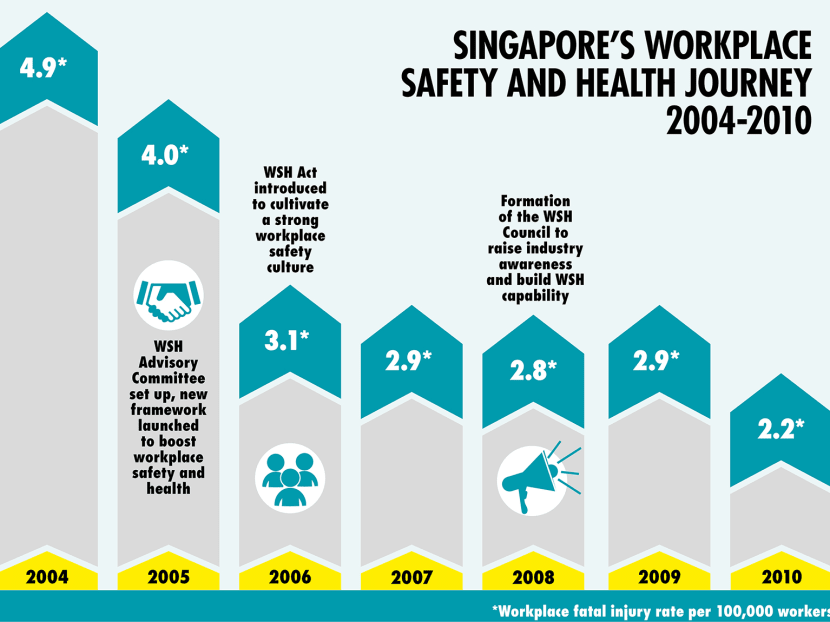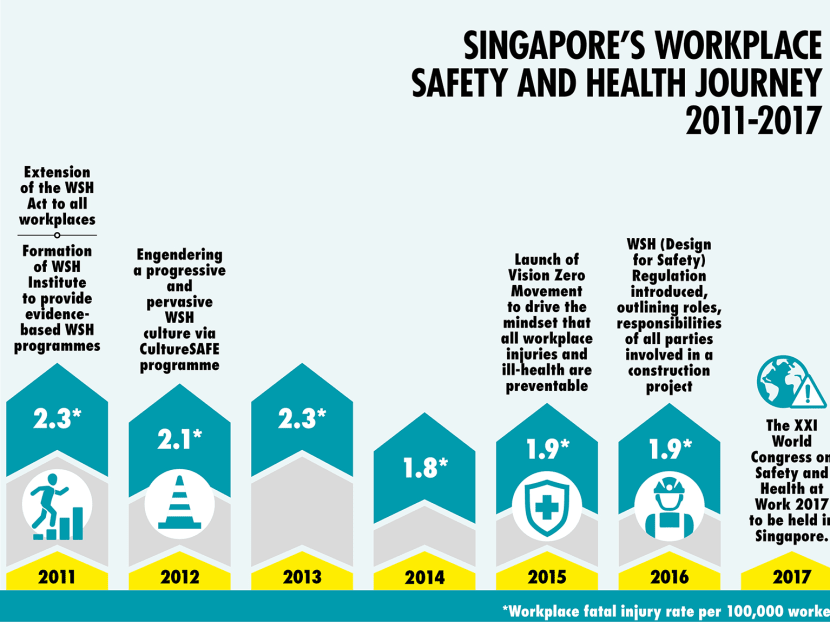Getting workers home safely
It’s a situation any worker will be familiar with in industries ranging from computing to construction: Meeting key objectives to keep business — and pay cheques — coming in. While unmet business objectives may hurt the bottomline, workplace safety lapses can exact a toll that can’t be described in dollars and cents: The loss of human life.
Speaking at the ProBE Plus Forum earlier this year, Mr Sam Tan, Minister of State for Manpower, said: “Making a living should not cost the worker his limbs or life. We owe it to the worker and his family to provide him with a safe and healthy workplace.
“We must continue to press on with our efforts to raise awareness, build strong workplace safety and health capabilities and extend the reach of risk management implementation across all workplaces to improve our workplace safety and health performance.”
“Workplace safety and health is everyone’s responsibility. Together, we can prevent all injuries and be healthy at work. Together, we can make ourselves and our fellow co-workers safe.”
VISION ZERO
Mr Tan’s comments reflect an approach that the Ministry of Manpower (MOM) has used for decades towards improving workplace safety and health: Drafting and enforcing regulations where needed, and engaging workers and companies through campaigns and training. Adopting this multi-faceted, tripartite approach has helped reduce accident and fatality rates over the years.
Said Er Ho Siong Hin, divisional director, Occupational Safety and Health Division, MOM: “Through these collaborative efforts, Singapore’s workplace fatality rate declined from 4.9 per 100,000 employed persons in 2004 to 1.8 per 100,000 employed persons in 2014.”
Despite the progress, one maxim still holds true: Even one injury is still one too many.
The MOM launched the Vision Zero movement in 2015, which aims to develop a mindset that all workplace injuries and ill-health are avoidable. A tall order? Arguably so, but this Mission: Improbable scenario means that tripartite players have constantly pushed and evolved to improve workplace health and safety standards.
When the MOM was known as the Ministry of Labour in post-independent Singapore, the focus lay in ensuring regulations were met, though it soon became apparent that this approach could only go so far.
DRIVING COLLABORATION, ENSURING COMPLIANCE
Mr Low Wong Fook is a former chief inspector of factories and director of industrial safety and divisional labour welfare at the Ministry of Labour. In 1974, when he was appointed chief inspector of the Factory Inspectorate, he faced an uphill task changing mindsets.
Workers were not as well educated as their modern counterparts. Some workers, he said, might not have even been aware that they were falling foul of regulations as compliance rates were low.
Safety technology was just not as advanced as it is today and many of the technologies being introduced into the economy, such as petrochemical plants, were new at the time. In an era when workers were more focused on bread-and-butter issues and less aware of the dangers they might have been facing, workplace health and safety was an intangible concept.
“You can’t show workplace health and safety to people, so we needed to be quite sophisticated to market this,” said Mr Low.
It was a perfect workplace health and safety storm that required all sides to work closely. Part of the equation involved regulation and enforcement. The other involved reaching out to workers and employers — these were the people who faced workplace situations daily, and who might be able to offer better solutions.
“When you work with them, you have to work in a collaborative way, rather than say: ‘I am an enforcer.’ It’s like drilling from within — you tap into the wisdom of workers and employers and work with them as our partners,” said Mr Low.
This evolved further in the 1980s and 1990s when companies were required to have their own in-house systems and rules. It helped ensure they complied with workplace health and safety regulations and allowed companies to take greater ownership of their workplace health and safety journey.
Said Er Ho: “The most significant change came about over the last 12 years when the law was changed from the Factories Act to the Workplace Safety and Health (WSH) Act.”
“It provides for duties and responsibilities from different stakeholders and also focuses on risk management and implementing, as far as reasonably practical, measures to eliminate or mitigate the risk,” added Er Ho.
SAFETY ABOVE ALL ELSE
Mr Tan Pui Guan, another former chief inspector of factories and director of industrial safety and divisional labour welfare at the Ministry of Labour, highlighted the crux of the matter.
“Safety first rather than production first. If you don’t have safety, then production is affected. At first employers didn’t know about safety and health, but after a few major incidents in the 1970s, that changed.”
One of the worst of these occurred in 1978, when an explosion aboard the Greek oil tanker Spyros killed 76 and injured 69 workers. The carnage at the scene of the accident left an indelible imprint on Mr Tan.
“The Spyros accident could have been avoided. We didn’t expect all the bodies. It was a needless loss of life.”
Added Mr Low: “You must deal with the human suffering. Although it doesn’t immediately affect you, it will come to you. After that, we put in place many safety management systems. We learned it the hard way.”
THE TECH PILLAR
This is why the adoption of new safety technologies has played a crucial role in improving workplace health and safety standards while improving efficiency.
Recent examples include the construction industry’s move towards pre-fabricated pre-furnished volumetric construction (PPVC). This means that some modular elements of buildings are built and finished in factories, transported to worksites and then installed in a building.
The advantage of this? Workplace health and safety risks are greatly reduced since most of the work is performed in a more controlled environment.
Another example of how tech has helped turn the tide has been the installation of data loggers in all mobile cranes. Said Er Ho: “The data loggers allow crane owners and occupiers to monitor the performance of crane operations, facilitate better planning of lifting operations and share the behaviour of crane operators.”
These efforts are part of a system that requires constant vigilance from workers, companies and MOM, because even the smallest of lapses can have potentially deadly consequences. Getting workers safely back to their loved ones daily may not be the most glamorous of tasks, but it’s certainly one that’s worth pursuing, relentlessly.
ADVANCING SAFETY, EXCHANGING IDEAS
The XXI World Congress on Safety and Health at Work 2017 will be held from Sept 3-6 at Marina Bay Sands. The congress is a forum for the exchange of knowledge, practices and experience between participants. Representatives can also network, lay the ground work for future cooperation and share knowledge to achieve occupational safety and health improvements.
Produced by Mediacorp Brand Studio Productions








